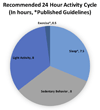Twenty-four Hours of Sleep, Sedentary Behavior, and Physical Activity with Nine Wearable Devices
- PMID: 26484953
- PMCID: PMC4760880
- DOI: 10.1249/MSS.0000000000000778
Twenty-four Hours of Sleep, Sedentary Behavior, and Physical Activity with Nine Wearable Devices
Abstract
Getting enough sleep, exercising, and limiting sedentary activities can greatly contribute to disease prevention and overall health and longevity. Measuring the full 24-h activity cycle-sleep, sedentary behavior (SED), light-intensity physical activity (LPA), and moderate-to-vigorous physical activity (MVPA)-may now be feasible using small wearable devices.
Purpose: This study compared nine devices for accuracy in a 24-h activity measurement.
Methods: Adults (n = 40, 47% male) wore nine devices for 24 h: ActiGraph GT3X+, activPAL, Fitbit One, GENEactiv, Jawbone Up, LUMOback, Nike Fuelband, Omron pedometer, and Z-Machine. Comparisons (with standards) were made for total sleep time (Z-machine), time spent in SED (activPAL), LPA (GT3X+), MVPA (GT3X+), and steps (Omron). Analysis included mean absolute percent error, equivalence testing, and Bland-Altman plots.
Results: Error rates ranged from 8.1% to 16.9% for sleep, 9.5% to 65.8% for SED, 19.7% to 28.0% for LPA, 51.8% to 92% for MVPA, and 14.1% to 29.9% for steps. Equivalence testing indicated that only two comparisons were significantly equivalent to standards: the LUMOback for SED and the GT3X+ for sleep. Bland-Altman plots indicated GT3X+ had the closest measurement for sleep, LUMOback for SED, GENEactiv for LPA, Fitbit for MVPA, and GT3X+ for steps.
Conclusions: Currently, no device accurately captures activity data across the entire 24-h day, but the future of activity measurement should aim for accurate 24-h measurement as a goal. Researchers should continue to select measurement devices on the basis of their primary outcomes of interest.
Conflict of interest statement
Figures



References
-
- Ainsworth B, Haskell W. 2011 compendium of physical activities: a second update of codes and MET values. Med. Sci. Sport. Exerc. 2011;43(8):1575–1581. - PubMed
-
- Atienza AA, Moser RP, Perna F, et al. Self-reported and objectively measured activity related to biomarkers using NHANES. Med. Sci. Sports Exerc. 2011;43:815–821. - PubMed
-
- Blair SN, Haskell WL, Ho P, et al. Assessment of habitual physical activity by a seven-day recall in a community survey and controlled experiments. Am. J. Epidemiol. 1985;122:794–804. - PubMed
Publication types
MeSH terms
Grants and funding
LinkOut - more resources
Full Text Sources
Other Literature Sources
Medical
Miscellaneous

